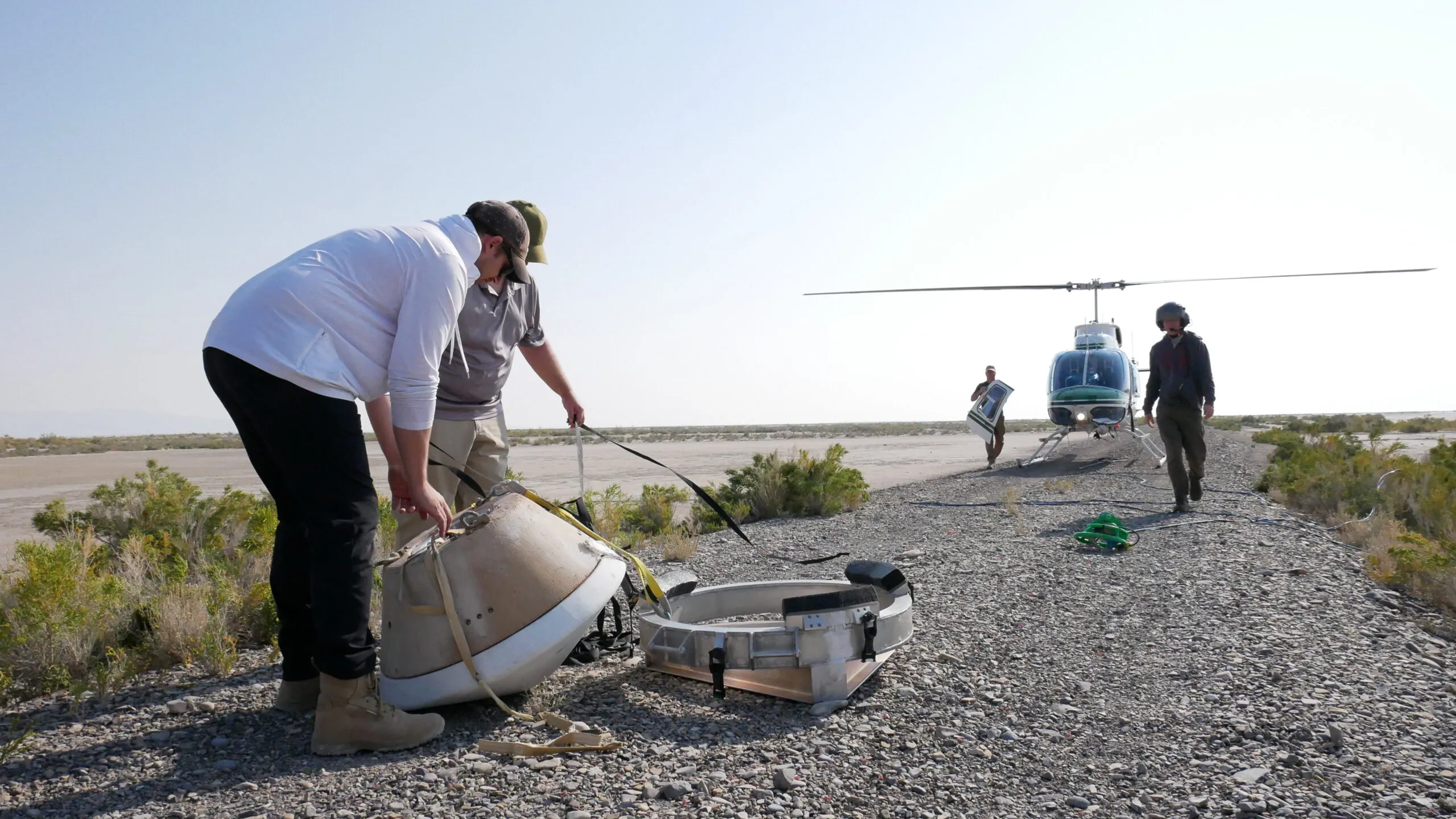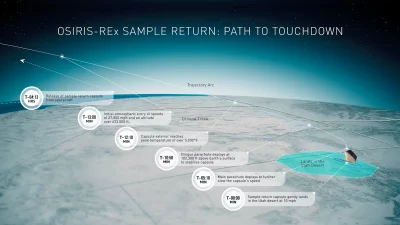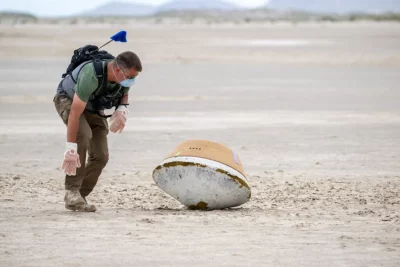
NASA’s Ben Ashman on OSIRIS-REx Sample Return Landing in Utah
Community
On September 24, NASA’s first asteroid sample return will land in the Utah desert—a predetermined area on the Department of Defense’s Utah Test and Training Range, southwest of Salt Lake City—thanks to OSIRIS-REx, a mission that’s been in the works for over a decade. Ben Ashman, a NASA flight dynamics system team member for OSIRIS-REx, chatted with SLUG about the details of the mission and the significance of the first asteroid sample return in the U.S.
SLUG: Could you give us a brief overview of the OSIRIS-REx mission?
Ashman: It’s an asteroid sample and return mission, and it’s part of NASA’s New Frontiers program. The mission was launched in 2016 and went out to an asteroid named Bennu, a near-Earth asteroid, meaning it’s not part of the main asteroid belt. We chose Bennu because it’s accessible—it’s in a location that we could get to relatively easily. Based on the observations from Earth, we were able to determine the composition, which is heavy in carbon—a key ingredient to forming lots of different compounds. Bennu is about 500 meters across, roughly the size of the Empire State Building, and a day on Bennu is about 4.5 hours.
SLUG: The mission launched in 2016. What happened next?

Ashman: It took two years to get there. Once we arrived at the asteroid in 2018, we then spent two years orbiting and began to map out the actual shape and topography, including what it looked like and its thermal properties. Once we were confident that we understood its gravitational properties, we then prepared to go into what’s called a frozen orbit—an orbit with a fixed orientation over the day/night dark line on the asteroid. OSIRIS-REx was able to orbit over that day/night “terminator” line because of the balance between the microgravity of this very small object and some of the dynamics of the orbit.
“OSIRIS-REx was able to orbit over that day/night “terminator” line because of the balance between the microgravity of this very small object and some of the dynamics of the orbit.”
SLUG: You spent two years doing flybys of the asteroid, studying it and finally locking into a frozen orbit. Of course, the next question must have been, “Where are we going to land this thing?”
Ashman: Correct. [From] the initial images that we got of Bennu from earth, (and I say images, but they were actually radar images from Arecibo, a RADIO telescope in Puerto Rico), we initially thought it was more of a sandy surface based on the way it heated and cooled throughout the day and night. Well, it turns out it was incredibly rocky. There were house-sized boulders strewn all over the place, so it was actually hard to find a spot with a landing zone that the [navigation team] felt confident would be safe.
“We initially thought it was more of a sandy surface based on the way it heated and cooled throughout the day and night. Well, it turns out it was incredibly rocky.”
SLUG: You guys ended up choosing the landing site, Nightingale. What happened next? Did you send a probe from the spacecraft down to the surface?
Ashman: We sent the entire spacecraft down.
SLUG: What!? That’s wild! So, we didn’t leave anything in orbit; the whole spacecraft came down to essentially kiss the surface to collect the sample?
Ashman: For this mission, the entire spacecraft descended down to the surface. By the time it was in its final descent, it was moving at the speed of a beetle running across the ground, around 10 centimeters per second.
SLUG: I know there were tons of dress rehearsals for this, but did anything unexpected happen when we actually went in for the sample collection?
Ashman: Yes! Instead of coming down and briefly touching the surface, we actually plunged into the surface. It turned out that not only was the material on the surface very loosely packed, but what appeared to be solid rocks were immediately pulverized when the sampling arm touched them. We didn’t expect the rocks themselves to just crumble into dust when touched. The arm ended up going more than a foot into the asteroid, and it probably would have kept going if we hadn’t fired our thrusters to back away.
“The arm ended up going more than a foot into the asteroid, and it probably would have kept going if we hadn’t fired our thrusters to back away.”
SLUG: Wow, that’s crazy. I remember there was supposed to be a blast of nitrogen when it got close to the surface to sort of kick up the dust so we could collect it.
Ashman: Yeah, the control arm was designed to press against the surface. They designed [it] for a surface with some resistance that would trigger nitrogen canisters to blow up material into the sample collector. The scariest part of the mission—and the most exciting—was when the sample canister had a flap stuck open because some chunks of Bennu were wedged in there, and we were actually losing samples. They were leaking out because the sample head was so full that it couldn’t close. That was the coolest part of the mission for me because it was sort of an Apollo 13–type moment—minus the risk to life, of course. The whole team had to pivot and improvise.

“The scariest part of the mission—and the most exciting—was when the sample canister had a flap stuck open because some chunks of Bennu were wedged in there, and we were actually losing samples.”
SLUG: What an honor to have contributed to such a historic mission for NASA. What is your favorite thing about NASA?
Ashman: NASA has this remarkable role, providing science and technology expertise and fostering a technical workforce. At the end of the day, it’s an exploration-driven, science-driven organization. If you compare NASA to any other space agency around the world, nobody even comes close to the level of investment that we have in space. I think that’s a remarkable thing.
SLUG: I remember when I first started working with The Planetary Society, I was surprised to learn that NASA divides its budget between all 50 states. People often think of NASA as some giant corporation, but they offer tons of contracts to anyone who wants to bid on them. Everyone has an opportunity to get involved with NASA.
Ashman: NASA is a force for economic growth in the state of Ohio, and this is even the case in places where you don’t have a NASA facility. It’s not just something that supports local businesses, contractors and suppliers across the state, but it’s also a real source of pride. It’s more than jobs—it’s good jobs, and it’s an enterprise that the whole community feels proud to have as part of their city. NASA provides value to communities whether you’re a space enthusiast or not.
“It’s more than jobs—it’s good jobs, and it’s an enterprise that the whole community feels proud to have as part of their city.”
SLUG: How old were you when you knew you wanted to work for NASA? Do you have any advice for future NASA applicants?
Ashman: I always thought NASA was cool. Growing up in Ohio, it really didn’t cross my mind as a feasible thing for me to do. I applied for internships a couple of times in college, and I never even heard back. Like, not even rejected. I just never heard anything. I really got involved once I got into grad school and started doing research with people at NASA. It’s a lot more attainable than people think. I’m always telling people, “Hey, apply for internships and keep an open mind about what kind of things you might work on. Don’t give up. Don’t ever give up.”
To follow OSIRIS-REx mission updates and learn more about the asteroid sample return landing in Utah, check out NASA’s website nasa.gov/osiris-rex.
Read more community-based articles here:
O2 Utah: Improving Air Quality to Improve Quality of Life
Breaking Bread as a Strategy for Resilience: Iowa House